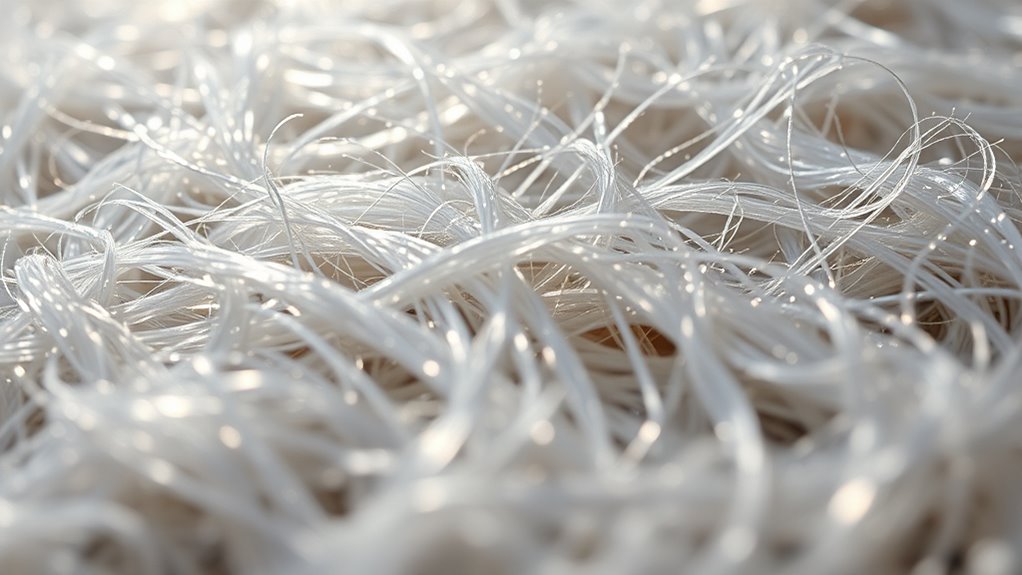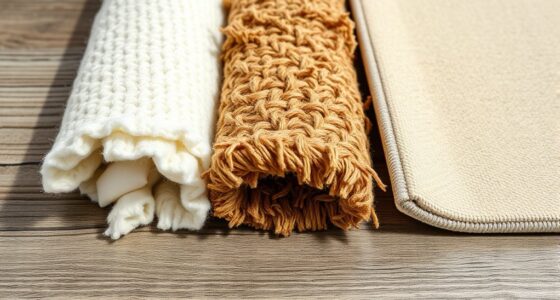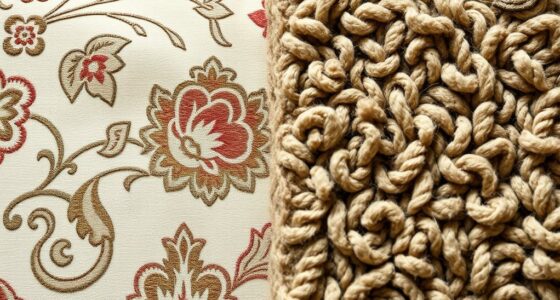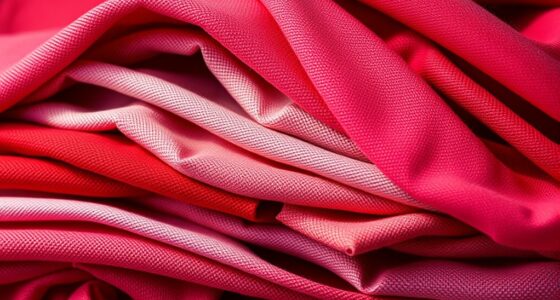Silk rug sheen comes from its fiber’s unique microscopic structure that affects how light reflects. You’ll notice the triangular cross-section of silk fibers and organized microfibrils that direct light at specific angles, creating a luminous glow. Fibre orientation and weaving patterns also influence how shiny or matte the surface appears. Understanding these microscopic features helps explain why silk rugs have such a vibrant, lasting sheen. Exploring this further reveals how light and fibre interplay craft their stunning visual appeal.
Key Takeaways
- Silk fibers have a triangular cross-section that directs light at sharp angles, enhancing their natural sheen.
- Microfibril arrangement within silk guides light reflection and creates optical interference, amplifying luminosity.
- The smooth, porous surface of silk fibers allows deep dye absorption and maximizes light play.
- Fibre orientation and weaving patterns influence sheen variations and surface reflectivity.
- Structural features like crystalline regions and fiber shape contribute to silk’s luminous, resilient appearance.
The Composition and Structure of Silk Fibres
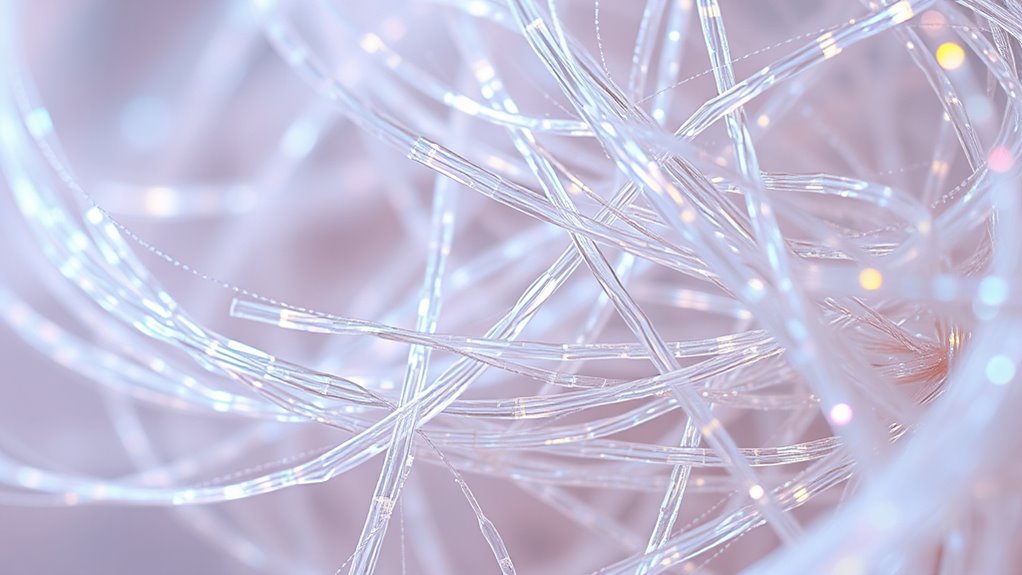
Silk fibers are primarily composed of proteins that give them their unique strength and luster. The structure of silk includes a core filament called fibroin, surrounded by a coating of sericin. This combination creates a flexible yet resilient fiber. The protein’s fiber elasticity allows silk to stretch and return to its original shape without damage, adding to its durability. Additionally, silk’s structure enhances dye absorption, enabling vibrant, long-lasting colors. The porous nature of the fibroin allows dyes to penetrate deeply, resulting in rich hues that highlight the fiber’s natural sheen. The crystalline regions within fibroin contribute to silk’s impressive mechanical properties, making it both strong and lightweight. Because of this composition, silk rugs display such a mesmerizing sheen and vibrant color palette.
How Light Interacts With Silk’S Surface
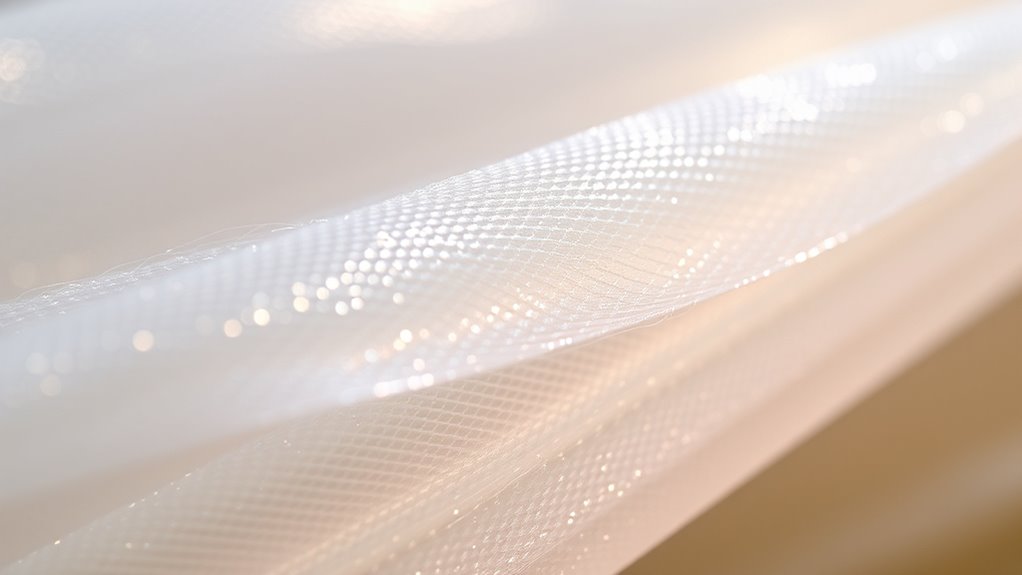
The way light interacts with silk’s surface is vital to its renowned sheen and luminous appearance. When light strikes silk fibers, the smooth, reflective surface causes light to scatter in a way that enhances its natural glow. Dye absorption also plays a role; silk’s ability to absorb dyes deeply affects how light reflects off its surface, influencing color vibrancy and sheen. Environmental effects, like exposure to sunlight, humidity, or pollutants, can alter the fiber’s surface, diminishing its reflective qualities over time. These changes impact how light interacts with the silk, often dulling its shine. Proper care and understanding of fiber surface properties can help maintain silk’s luminous qualities. Understanding this interaction helps explain why silk maintains its luminous appeal initially but can degrade with environmental exposure. This microscopic surface plays a pivotal role in the silk’s captivating light play.
The Role of Microfibrils in Creating Shine
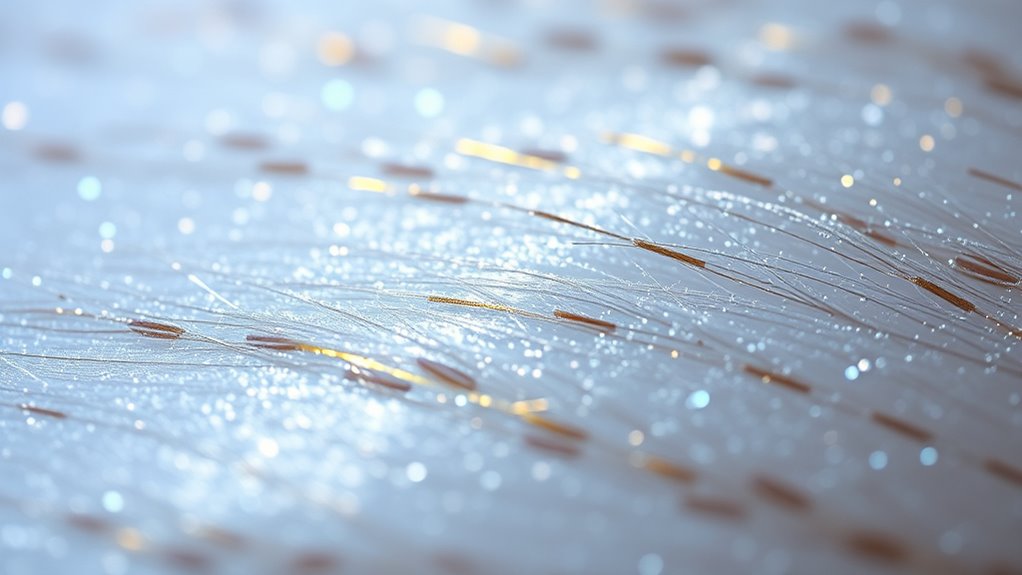
Microfibrils within silk fibers play a crucial role in creating its signature shine by guiding how light reflects off the surface. The microfibril arrangement determines how light interacts with the fiber, influencing the quality of its sheen. When light hits the silk, it undergoes optical interference as it reflects between the tightly packed microfibrils. This interference amplifies certain wavelengths, producing the luminous glow characteristic of silk. The precise organization of these microfibrils ensures consistent light reflection, enhancing the fiber’s brilliance. Variations in the arrangement can lead to differences in sheen, but the fundamental process remains the same: microfibrils shape light behavior at a microscopic level, creating the mesmerizing shine that makes silk so visually appealing. Additionally, the fiber structure influences how durable and flexible the silk remains, further contributing to its luxurious qualities.
Variations in Sheen Due to Fibre Orientation
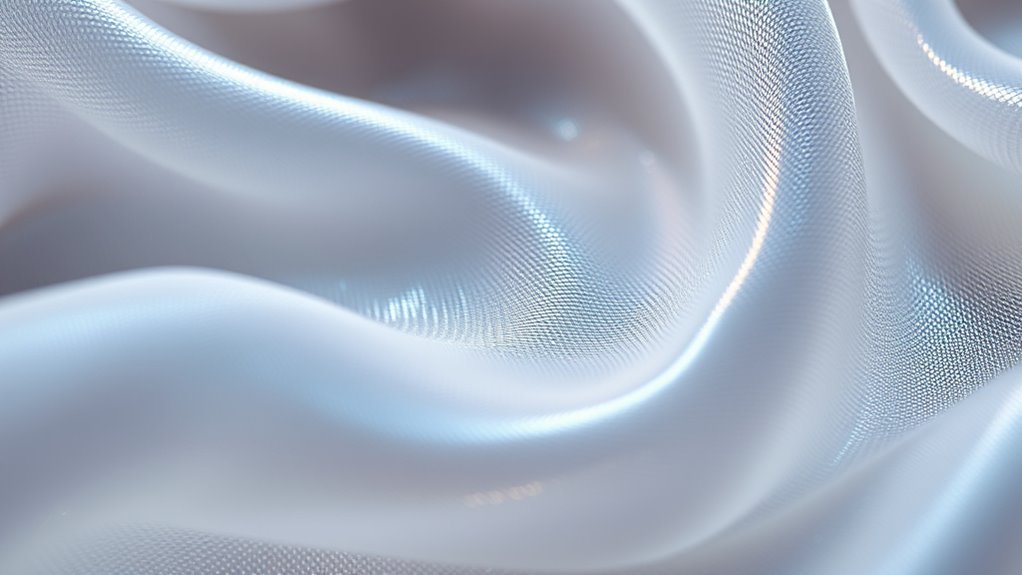
Fibre orientation markedly influences the sheen of silk by altering how light reflects off its surface. When fibres are aligned uniformly, light reflects smoothly, creating a consistent, lustrous appearance. Conversely, fibres oriented irregularly produce varied light reflection, resulting in a less uniform sheen. This orientation also impacts dye absorption; fibres aligned parallel tend to absorb dyes more evenly, enhancing color vibrancy. Additionally, fibre arrangement affects wear resistance—aligned fibres resist wear better, maintaining sheen longer. When fibres are oriented at different angles, the rug may develop uneven wear patterns, causing sheen variations over time. Understanding fibre orientation helps you identify the quality and durability of silk rugs, as well as how their appearance might change with use and age.
The Impact of Weaving Techniques on Light Reflection
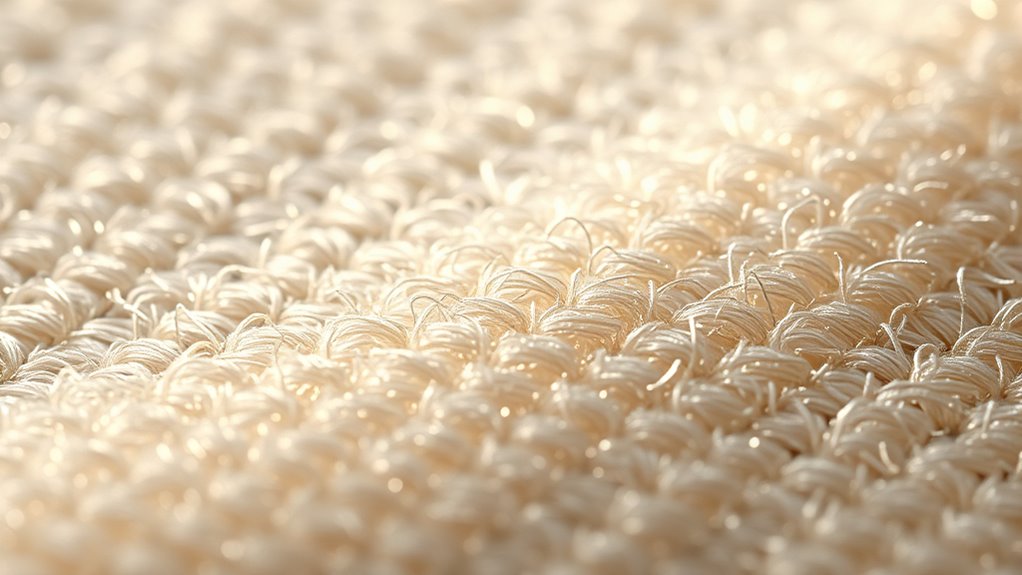
Your choice of weaving pattern directly affects how light reflects off a silk rug, giving it a unique sheen. Thicker yarns tend to create a more lustrous surface, while finer yarns offer subtle luster. By understanding these techniques, you can better appreciate how craftsmanship influences a rug’s appearance. Implementing vertical storage solutions can also help preserve the quality and longevity of your silk rug.
Weaving Patterns and Sheen
The weaving pattern of a silk rug profoundly influences its sheen by affecting how light interacts with its surface. Different patterns create varied surface textures, which change how light reflects and refracts. Tight, intricate weaves often produce a smoother surface, enhancing dye absorption and dye penetration, resulting in vibrant colors and a subtle sheen. Conversely, looser weaves may produce uneven dye absorption, leading to less uniform color and a duller appearance. The way yarns are interlaced determines the fiber’s orientation, impacting light’s reflection angles. By understanding these pattern effects, you can appreciate how the craftsmanship influences the rug’s luminous qualities, making certain areas shimmer more vividly based on weaving density and technique. This subtle interplay shapes the overall illumination and visual depth of the silk rug.
Yarn Thickness and Luster
Yarn thickness plays a crucial role in how a silk rug reflects light, directly impacting its luster. Thicker yarns create a more pronounced surface, enhancing dye penetration and resulting in richer colors. Conversely, thinner yarns allow light to pass through more easily, giving a softer sheen. The fibre’s flexibility also influences luster; flexible fibres bend and reflect light differently, adding depth to the surface. Weaving techniques that use varied yarn thicknesses can produce diverse light reflections, emphasizing or softening sheen levels. Here’s a quick overview:
| Yarn Thickness | Dye Penetration | Fibre Flexibility |
|---|---|---|
| Thick | Deep | Less flexible |
| Medium | Moderate | Moderately flexible |
| Thin | Shallow | Highly flexible |
This interplay creates the dynamic light play seen in exquisite silk rugs. Additionally, understanding the light reflection properties of different fibres can aid in selecting the right weaving techniques for desired visual effects.
Comparing Silk Sheen to Other Natural Fibres
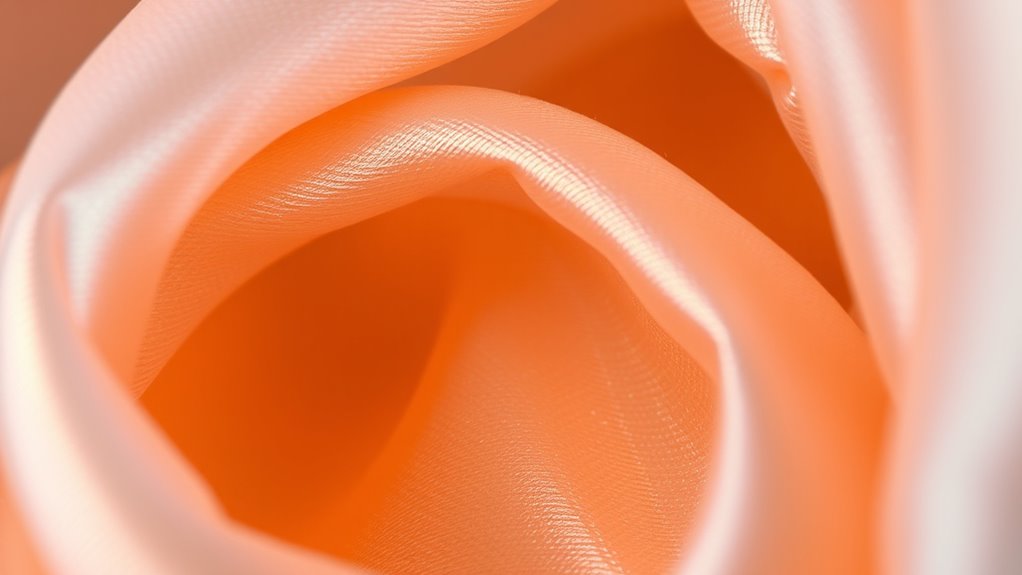
When comparing silk sheen to other natural fibers, you’ll notice silk’s exceptional luster and reflective qualities stand out. Its fiber structure, smooth and uniform, enhances this glow, unlike coarser fibers like wool or cotton. Understanding these differences helps you appreciate why silk offers a unique visual appeal. Additionally, the processing techniques used in silk production, such as careful harvesting and gentle weaving, contribute to its distinctive sheen and durability.
Luster and Reflection
Silk’s natural sheen stands out among fibers because of its unique ability to reflect light with a luminous glow. This luster results from the fiber’s smooth surface and internal structure, giving silk a characteristic shine that’s more reflective than wool or cotton. When it comes to dye absorption, silk takes dyes vividly, enhancing its reflective qualities and making colors appear richer. Its fiber durability ensures that the sheen remains vibrant over time, resisting dullness and wear. Unlike other natural fibers, silk’s light play creates a subtle, elegant shimmer that appeals to both aesthetic and functional qualities. This combination of dye absorption, fiber durability, and inherent reflectivity makes silk a prized material for rugs and textiles that require a luminous, enduring sheen.
Fiber Structure Differences
The unique luster of silk stems from its distinct fiber structure, which differs markedly from other natural fibers like wool and cotton. Silk’s smooth, triangular cross-section causes light to reflect at sharp angles, enhancing its sheen. Unlike wool, which has a scaly surface, silk’s surface allows for better dye absorption, resulting in richer, more vibrant colors. Cotton fibers are flatter and less elastic, limiting their ability to stretch and recover. With silk’s high fibre elasticity, you can see how it maintains shape and resilience, adding to its luxurious feel. Imagine these structural differences:
- Triangular cross-section for brilliant reflection
- Smooth surface for superior dye absorption
- Elastic fibers that stretch and recover easily
These features collectively give silk its iconic sheen and durability.
Frequently Asked Questions
How Does Silk’S Sheen Change Over Time With Exposure to Light?
When exposed to light over time, silk’s sheen can fade, revealing fiber degradation and diminishing its original luster. Environmental effects like UV rays and humidity accelerate this process, causing the silk fibers to weaken and lose their reflective qualities. You might notice a duller appearance as the sheen diminishes, making it essential to protect silk rugs from prolonged light exposure to preserve their vibrant, glossy look.
What Microscopic Features Contribute Most to Silk’s Unique Light Play?
You observe that silk’s unique light play results mainly from its fiber arrangement and surface smoothness. The tightly packed fibers create micro-scale structures that reflect and refract light, producing a luminous sheen. Its smooth surface allows light to bounce uniformly, enhancing this effect. These microscopic features work together, making silk’s surface appear radiant and dynamic under different lighting conditions, giving it that distinctive, mesmerizing glow.
Can Silk’s Sheen Be Artificially Enhanced or Altered?
You can artificially enhance or alter silk’s sheen through various dyeing techniques and fiber treatments. For example, applying specific dyes, like acid dyes, can deepen its luster, while treatments such as silk glossing or coating with resins can boost its reflective qualities. These methods allow you to customize silk’s appearance, making it more vibrant or glossy, but be cautious, as some treatments may affect the fabric’s natural softness and longevity.
How Does Silk’S Sheen Vary Between Different Silk Species?
Imagine you’re a Victorian scientist examining silk fibers under a microscope. You’d notice that different silk species, like mulberry and tussah, vary in fiber structure, impacting their sheen. These variations affect light refraction dynamics, causing some silks to shimmer more vividly. So, silk’s sheen isn’t uniform; it depends on the fiber’s microscopic structure, which influences how light interacts and reflects, creating unique luminous qualities across silk types.
What Influences the Durability of Silk’S Light-Reflective Properties?
You can influence silk’s durability of light-reflective properties mainly through its fiber cross section and surface smoothness. A well-formed fiber cross section ensures consistent light reflection, while a smoother surface reduces wear and maintains sheen over time. When you care for silk properly, avoiding rough handling and cleaning it gently, you help uphold its surface smoothness, keeping that beautiful, lustrous shine vibrant and lasting longer.
Conclusion
Now that you’ve glimpsed the microscopic magic behind silk’s radiant sheen, you realize it’s like capturing a piece of the cosmos in every fiber. The way microfibrils and weaving techniques dance with light creates a brilliance that outshines even the stars. This incredible interplay makes silk not just a fabric, but a luminous masterpiece. Once you see silk’s shimmer up close, you’ll never look at it the same way again—it’s pure, celestial enchantment.
